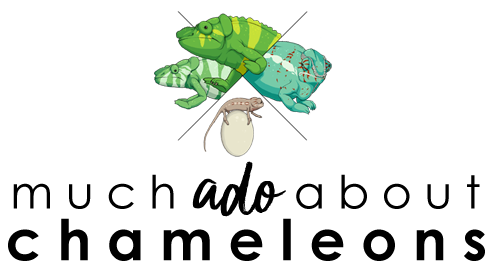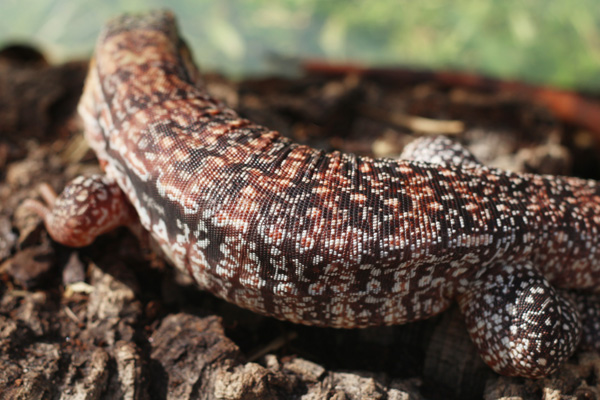A free-range (FR) is typically something you associate with poultry, but the term has found its way into a growing, alternative trend on how to keep chameleons. In this blog I talk a lot about the best screen cages to use and how best to set them up, but few people know that for over a year my chameleons had the run of their own room (and part of the living room) in what was a huge FR.
The idea consists of housing chameleons without cage walls, allowing them relative freedom to move about but still providing all their husbandry needs. This means that they still need their correct lighting, access to water, and food but without the cage walls. Many chameleons do incredibly well with this set-up, including but not limited to wild caught chameleons and large chameleon species (like Meller's, for example, who fit into both those descriptors.)
 |
| One side of my free-range room, with Cerberus the Ambilobe hanging out. |
THE GOOD
1. Chameleons tend to respond really well to not being caged. Even very aggressive, terrified chameleons usually relax and become more comfortable with people when they do not feel trapped/cornered in a cage. The great people at
The Chameleon Farm have a blog where they explain how to raise social chameleons, which includes free-ranging first and foremost. Their methods are amazing and I highly recommend checking it out.
 |
| Cobalt and Daedalus eating from the cricket bin together. |
2. Depending on the size of the FR, a large one allows them to exercise more, which lets them maintain a healthy weight and muscle tone. Obesity in chameleons is bad, and usually leads to problems with their liver eventually.
3. It lets them regulate their needs better. By not being trapped under a light all day long, they are able to choose whether to be under the heat light or the UVB bulb throughout the day.
4. You see a much more natural range of behavior and (dare I say it...) lots of personality. It seems that more space really brings out the full behavior spectrum of a chameleon, with all their quirks, weird little habits, and favorite activities. Males that would have fought otherwise forged "friendships."
THE BAD
1. You cannot set food items free in the cage for them to catch. You have to get used to either cup or hand feeding. So get used to (or get a set of tongs for) holding those bugs! And get used to the idea of a few of them escaping every so often from your grasp (or their mouth) and running around your home. Roommates may not be happy about this.
2. You have to hang the lights from the ceiling or something very tall. So making holes in the ceiling of a home you rent may not be a great option. But you don't want the chameleon climbing up the cord, onto the light, and burning himself. So I usually screw something into the ceiling from which I can hang my lights and then tape the cord along the wall, so no one can climb up.
 |
| See how the lights hang from the ceiling. And the metal frame for the misting system. |
4. Figuring out how to collect the mist/drip water is a bigger pain. You'll definitely have to get creative, or you'll end up ruining your floors. My solution was to turn my cage drainage tables into stands for my free range plants, and double as the drainage: How To Make A Drainage Table
A great idea to make a FR safer and keep them from wandering away into an unsafe area is to make a little smooth wall that they can't get over. One way to do this would be to take sheets of stiff acrylic, for example, cut them so they are taller than your chameleon is when standing, and make a fence around the FR perimeter. Glue or secure the pieces along the outside, so they can't climb up hinges or glue tracks. Something like the idea below:
THE UGLY
1. Free-ranging can be very dangerous. Pets (especially cats) are a huge risk, as are small children, electrical wires, sharp objects, etc. You have to carefully chameleon-proof the room they are in and then be very diligent about keeping other pets away. And then you have to be careful to check where you're walking, that you don't run them over with the door coming into the room, that you don't leave windows open, etc.
ADDITIONAL THOUGHTS
 |
| How many panthers can you spot in this photo? |
I free-ranged my entire gang for a year, and observed such amazing behavior from all of them. I saw them make friendships with unlikely partners (for example, two panther males became the best of friends). I saw how each one marked a territory within the room for himself, and they all respected each other. They would take turns eating from the feeding station or just share, depending on their mood. I saw them really communicating with each other via body language and settling disputes peacefully. It really was fascinating.
However, I did have to constantly check on them to make sure everything was ok, they were all still there, and find the one who maybe had wandered away looking for more food. It was more stressful than knowing they were each in their separate cages, safe and sound. And when I moved I decided to just make them each very large cages to live in.
But I do have plans to do it again when I am in a home where it is feasible again. With a little pre-planning and some ingenuity it's an amazing way to keep these animals.
But I do have plans to do it again when I am in a home where it is feasible again. With a little pre-planning and some ingenuity it's an amazing way to keep these animals.
Ambilobe and Nosy Be males became best friends. They'd drink off of each other.
|
















Hello Olimipia! I can spend hours on your blog. So much wonderful information. Thank you so much for sharing all of these amazing experiances with us. I love your ability to present cham keeping in such a simple and organized way with a touch of cuteness. Such as your adorable pet binders. Great ideas! The above picture displays an outdoor free range that appears to be on an apartment porch. Did you ever worry about birds when your guy was still little? I have just one artificial 6ft tree on my 3rd story apartment patio that I like to set my cham out on my days off. At my complex we have quite a few sparrows swooping in throughout the morning and I wonder if one of them would attempt to snatch up my 3.5 month old panther. I espescially worry while hes out on a limb basking, not so much when he is just hanging out somewhat hidden in the leaves.
ReplyDeleteHey Clarissa! Thanks for the kind words about the blog! The porch in the picture was actually 100% screened in, so it was like a giant cage. That's the only way I felt comfortable leaving him out there for hours, because he couldn't get away and nothing could come and get him. I don't believe that sparrows specifically would be a danger but you just never know, something else like a black bird or a small hawk could also spot him and take him away. But it's less likely to be a problem if you're out there with him. I will sometimes put my current Meller's chameleons out on trees on my current terrace and even though they're 1 pound lizards I still hang out nearby, to deter hawks or crows that might still be capable of flying away with them.
DeleteThats awesome! A screened patio would be perfect. Anyway, thanks for your input :)
ReplyDeleteIs my chameleon smart enough to go to the area with the uvb shining? I have a small free range, and there's no way it covers the whole area. Seems like he's never under it. Do I have to make it cover the entire FR?
ReplyDeleteYes and no, your chameleon should be able to see the UVB and get under it if needed. However, he may not like the UVB light for any number of reasons (he doesn't like where it is, that side of the FR is less exciting, he has a better view from a different area, whatever) and may not be as inspired to go under it, even if he needs it. So if he really is never using it then you'll have to move it or see if you need to get a longer light. Perhaps if he has a favorite spot on the FR you can put the light right over.
DeleteHello - I am new to this and appreciate your thoughts. I have a very docile one year Panther. I have just moved his cage outside into a screened in porch. There are plants in there and lots of sun at various times during the day. I left the cage door opend and am hoping he will go there for water. My thought is to cage him at night and put in his food so he can feed. Does that make sense? Appreciate any help. I can be reached at bccorning@gmail.com.
DeleteHello Olympia~
ReplyDeleteMy daughter wants a chameleon and I'm just not a fan of keeping animals in cages. We want to try FR. I have a huge ficus tree in the corner of the living room near a window. I thought I could buy a little mister, a heat bulb and maybe do a small netting around the bottom part if the tree to let bugs loose in. Does the Cham need additional lighting other than natural light??
Thanks so much for your time and love of these cool creatures.
Hi April,
DeleteYou will need to hang a UVB bulb as well. UV does not travel well through glass windows so unless the window is open all the time it will be best to suspend a linear fluorescent bulb over the tree. Something like a Reptisun 10.0, for example. That, in combination with a basking light, should be all the light the chameleon needs. Let me know if you need anything else!
Hi Olimpia,
ReplyDeleteGreat article, though there is one question I have. I had a Jackson that I would let roam in our small screened in porch where we had two shaded plants when he wasn't in his cage inside. He really loved being outside and would routinely crawl to the screen to bask in the direct sunlight then back to the plants. My question is, what are risks of infection from parasites by letting them roam in a setup like this? The porch is of course exposed to the elements and cleaning would be a pain on regular basis.